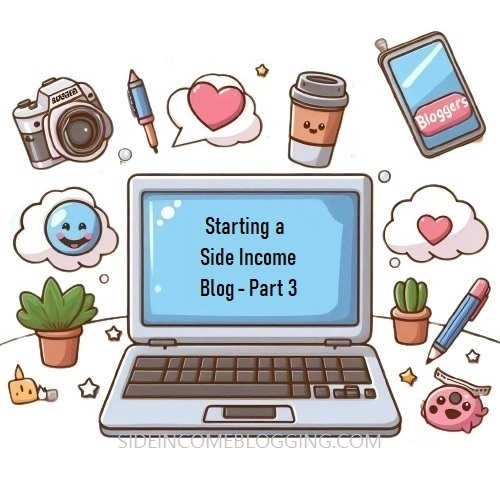Continuing from: ← Starting a Side Income Blog – Part 2
“This post contains affiliate links. I may earn a commission if you make a purchase, at no extra cost to you.”
Blog Schedule
At this stage it’s important to focus on content for your blog and we will go over tasks that should be considered when starting a side income blog. These tasks include some SEO considerations and maintenance and are broken down into initial, weekly, monthly and those specific to posting.
To do Initially:
Choose your topic niche.
Choose your blogging platform. A self-hosted WordPress.org site is recommended. Register a domain name that aligns with your topic or purchase an aftermarket domain and purchase webhosting.
Design your WordPress theme. It’s a good idea to do this in a local development environment.
Prepare content for around 5 posts for your blog. Consider making an about or contact page. Upload your blog with your 5 posts to your webhost and launch your blog on the internet to be accessed publicly through your domain name.
Consider initial SEO strategies, including signing up for Google Search Console, Google Analytics and Bing Webmaster Tools, creating a sitemap and submitting it to Google and Bing.
To do Weekly:
Post at least one new article.
Work on updating internal linking for your posts.
Promote your blog through social media, like Pinterest and Facebook, as well as through ongoing SEO, guest posting and to online communities.
Use different avenues to monetise your blog, such as finding new affiliate links.
To do Monthly:
Update content that is outdated.
Specific to Posting:
Articles (SEO considerations):
Include meta descriptions for posts, using an SEO plugin like Yoast SEO
Consider submitting sitemaps to Google Search Console after you create new articles, until your site gains traction, then only submit sitemaps for major changes for your site to Google.
Images:
When possible, include featured images with your posts.
When uploading images, including featured images, use image ‘alt tags’ and informative file names, as an SEO consideration.
Try to choose the correct size for images. Images that are too small will result in too low resolution and images too large will add extra unnecessary delay to your webpage loading time.
Videos:
Videos that are relevant should be used when necessary.
They should be high quality.
Links:
Link internally to related blog posts.
Tips for Blogging
- Utilise WordPress plugins. For example, while transitioning your blog from a local development environment to live on the internet, make use of a ‘coming soon’ plugin, if necessary, that will display a coming soon message when someone accesses your domain name. Another example is to use a Table of Contents plugin if necessary, such as the one used by this blog.
- Make your design comfortable for users for a good user experience (UX). It should also be responsive, which means it will work on different devices such as laptop, mobile and tablet. Many themes available are responsive or when using a theme page builder such as Beaver Builder to develop your blog, it comes fully responsive out of the box.
- Utilise social media, such as Facebook and Pinterest. Also integrate links from your site to relevant platforms you use.
- An AI chatbot, such as ChatGPT shouldn’t be used instead of writing content yourself, but it can help with brainstorming and core ideas. It can also help with such things as choosing your subniche topic for your blog and to create dynamic images.
- Do a 404 redirect to your homepage. This is especially useful if when choosing a domain name for your blog, you go with an aftermarket domain. By installing and activating the plugin Redirect 404 to homepage” in WordPress, it will send any traffic coming in that doesn’t land on an existing page for your blog to land on your homepage, rather than displaying an error.
- Plan and prepare blog posts beforehand to maintain blog consistency. Especially relevant when starting your blog. When developing on a local development environment, before launching your blog on the internet, it’s a good idea to ensure you have content you can use to consistently post. It’s also important if you blog regularly and are unable to continue, for example if your are going away on holidays, to prepar posts beforehand and set up a publish date. This can be done from the WordPress dashboard, by navigating to the quick edit link next to a post and setting your desired publish date.
- Monitor your sites performance through Google Analytics, Google Search Console and Bing Webmaster Tools to gain insights.

